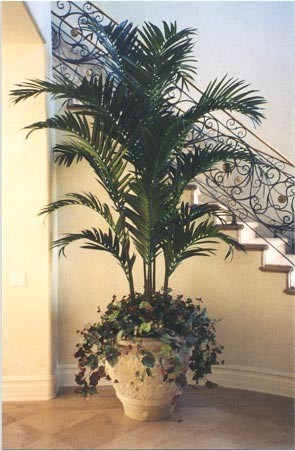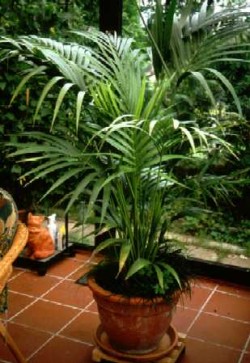|
Plants for your home
(By Mary Efanti)
Kentia / Lady Palm
 Description - Origin Description - Origin
A kentia tree is one of the best suggestions for interior decoration as its bold appearance will attract attention. Elegant and airy, it will add a tropical note in any room plus a sense of elegance. It is ideal for use in both homes and office spaces.
Kentia comes from Lord Howe island, situated NE of Australia. This tropical island itís the only place on earth where kentias grow in nature.
Kentia has a thin basic trunk with long thin stems. Palm airy leaves are on top of the stems. Its development is rather slow, so it can stay in the same pot for a long time. Although kentias are rather expensive to get, they are one of the hardiest and easily adaptable indoor
plants.
Care
Kentias do not stand direct
sunlight. Although they can easily grow in spaces with less light, they will not survive spots with no natural
light. Their development is slow but if they are in a room with lots of natural light
(filtered light), then their development will be enhanced and their shape will get more
compact. The ideal orientation for plants is next to a north or east window. A little direct sunlight in winter will not harm your
plant, but donít let the plant get any direct sunlight during the hot summer months because its leaves will get
sunburned.
Also avoid exposing the plant to cold drafts or very low temperatures because the leaves will also get
burned. Do not let kentia leaves/fronts touch windows during the night if the outside temperature is very
low.
And never use leaf polishing sprays on kentias. Some of the ingredients contained into such sprays are very harmful to kentias and the leaves will
die.
Like all palms, kentias can not be pruned. Their shape and way of development does not allow any
pruning. The size of a mature kentia is amazing. They can easily reach or exceed 2 meters in height although their lower
leaves/stems hardly reach 1 meter. The space a mature plant will need is much bigger since their stems lean around the
plant. So place kentias in corners or isolated spots you want to make look better or hide the
background. Also, when you choose a spot, make an effort to avoid high traffic areas so that passerbyís do not touch the plant all the
time.
Before watering, always check the surface of the soil. The amount and frequency of watering varies according to seasons and conditions such as temperature and
humidity. If you feel the soil being moist, do not water. Water only if the soil feels dry to the
touch.
Every time you water, use plenty of water to soak the whole root ball. Water until you see water coming out of the drainage holes. Always empty the excess water from the pot tray to avoid root
rot.
 As kentias grow to impressive
sizes, they get really hard to move around. Try coming up with an easy way to remove the water remaining in the
tray. A metal pot holder with two levels would be a good idea. On the top level you place the pot and then the tray on the second
level, just below the pot. If needed, you can remove the tray only, get rid of the water and then put it back in place without having to move a huge heavy pot
around. As kentias grow to impressive
sizes, they get really hard to move around. Try coming up with an easy way to remove the water remaining in the
tray. A metal pot holder with two levels would be a good idea. On the top level you place the pot and then the tray on the second
level, just below the pot. If needed, you can remove the tray only, get rid of the water and then put it back in place without having to move a huge heavy pot
around.
If your pot is into a decorative cas-pot, place a building block into the tray and have the pot sit on
it. In this way, you can ensure your plant does not sit in water. Also, plastic pumps used for getting oil or wine out of barrels could help remove the water without moving the
pot.
Kentias need high humidity in their
environment. In their natural habitat, kentias enjoy high levels of humidity while in our indoor settings humidity is usually very
low, the crisp edges of the leaves indicate that more humidity is needed. To add humidity to the
plant, use a humidifier or a wet pebble/sand tray. And your plant will be a lot happier if you spray it with lukewarm water as often as
possible.
Palms in general do not like their roots being disturbed. With their slow
development, kentias can stay in the same pot for 3-5 years. To see if itís time to repot try sliding the root ball out of the pot when the soil is
dry. If the ball surface is more roots than soil, then itís time to repot. Try to use pots in the same
shape, only 1 or 2 sizes bigger than the old pot.
Their soil should be a light mix and contain perlite to maintain humidity, also make sure it has excellent
drainage.
You can use any fertilizer intended for foliage plants, according to the instructions on the
label. Only fertilize the plant while it is in active growth, usually March through the beginning of
October.
Indoor plants seldom get insect infestations and diseases, less often than outdoor
plants. But if you have a garden or plants on your balcony, make sure to check your kentia often for signs of disease or
insects. Kentias are prone to scale and spider mites. If you notice the problem early
enough, get hold of products to fight off the infestation. And remember that, same as with
people, prevention is the best cure. Cleaning the leaves often with lukewarm water and soap (2-3 drops of dishwashing liquid in 1 lt of
water) can radically reduce the chance of your plant being infested with these
insects.
Kentias may be expensive, but they are so beautiful, impressive and hardy. They are the best suggestion for decorating any area so they are well worth their money and your
effort.
Mary Efanti
[email protected]
|
